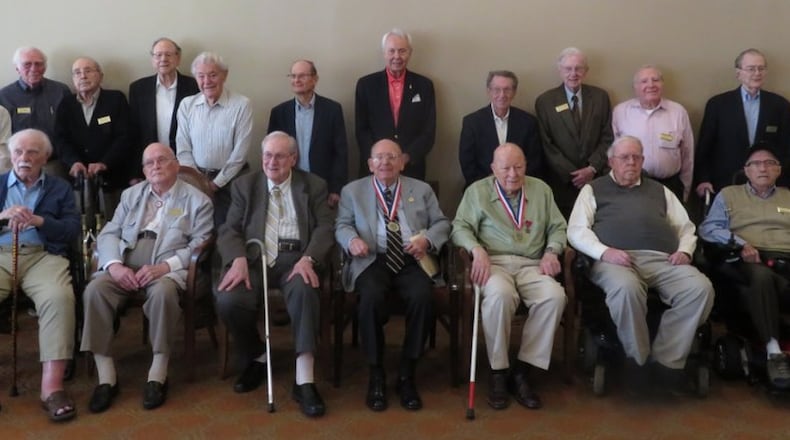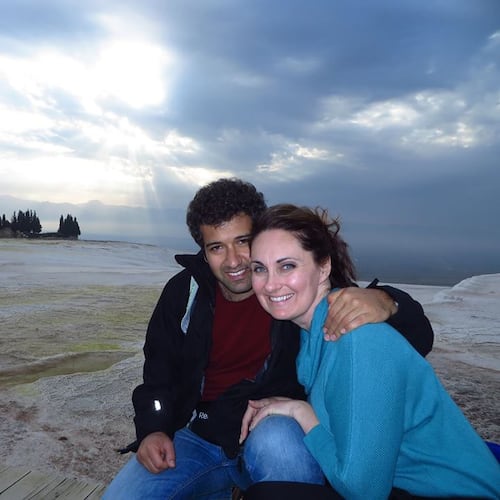This week, Hilbert Margol should have been wandering around Munich and the nearby Dachau concentration camp he came across 75 years ago as a stunned young soldier.
Margol and his twin, Howard, who is now gone, were among the first Americans to stumble upon the horrific operation. Their artillery unit had set up nearby and they went to investigate an odor.
They came across boxcars and opened a door. “It was filled with bodies in grotesque positions,” he said. They entered the compound. It was deadly quiet with survivors staring at them.
"We just did not understand when we were seeing," said Margol, who is Jewish.
Margol, a 96-year-old Dunwoody resident retired from the furniture business, wanted to make a pilgrimage to Germany and Austria to retrace his long-ago steps. The trip was canceled because of the coronavirus pandemic.
Margol will appear on a National Geographic Channel special, "WWII in Europe: Voices from the Front," which premieres Thursday, May 21, at 8 p.m. Eastern.
I called Margol because Friday is the 75th anniversary of VE Day, the May 8, 1945, surrender of Germany to end World War II in Europe. But in interviews with four very old soldiers, I was surprised to hear that they — to a man — did not have strong memories of that day.
There was good reason. “We weren’t excited because we knew the war was still going on in the Pacific,” Margol said of that historic day. “We figured we’d have to go fight there.”
These witnesses to history are becoming that: History. They are the remnants of 16 million Americans who served during what they call "The War." Last year, fewer than 400,000 were still alive, according to the Department of Veterans Affairs. The VA estimated perhaps 250,000 would still be with us this year.
Those I spoke with this week were all north of 95 years old, although three of them, including Margol, still drive. In fact, he recently got a haircut when Gov. Brian Kemp opened up the state.
Doug Wexler, an infantryman who fought at the Battle of the Bulge, had similarly vague recollections about VE Day. He was in Germany near the Rhine River when the end came.
“I can’t say we fired guns or jumped up and down or drank wine,” said Wexler, 95. “I don’t have a good recollection. It was just a day.”
Three months later, his unit was on a ship crossing the Atlantic Ocean headed for the Panama Canal and then to Okinawa, Japan. Then came the atomic bombs, Japan’s surrender, and a change of course.
The ship’s captain came on the intercom: “Attention, all hands, watch the shadow of the ship change as we head to New York.”
He and a sergeant went below deck to celebrate with a bottle of Armagnac.
I met Wexler in 2016 when he emailed me after I bashed the Atlanta Braves in a column. He, too, didn't like to see Major League teams soaking taxpayers to build stadiums and was boycotting the team. He still is. WWII vets can be steadfast.
He contacted me again last June when I wrote about the 75th anniversary of D-Day and how hard it was to find veterans from that war. Most of those in my file at the time had died. He reminded me of his service. I apologized, saying he wasn't listed in my WWII phone file. "You're in my 'Fans Mad at the Braves' file,'" I said.
RELATED FROM TORPY: 75 years after D-Day, finding WWII vets is the battle
Actually, that column brought about a dozen phone messages and about 30 emails from aged veterans. Wexler summed it up: “There’s a few of us codgers still kicking.”
I got a call from Korean War vet Jim Whitehurst, who lives in a senior center called Lenbrook in Buckhead. There were a ton of WWII vets there, he said. He gave me a list of 29 and rounded up 21 the next day for a group photo. However, I had a family emergency and was unable to attend.
This week, he had the group portrait sent over. As we went down the list of the 29 veterans from last year, five are now dead.
Lavelle Beene, 97, is an old Army scout who endured 195 straight days of combat in a unit called the Timber Wolves, an outfit that preferred to fight at night.
His stories are the stuff of movies, of lying low to avoid vast numbers of enemy troops, of holding a dying friend, of meeting up with the Russians, of single-handedly capturing 20 Germans desperate to end their fruitless war.
Beene, who became a minister after the war, was one of the 21 vets who posed for the portrait last year. Because of COVID-19, he is now cloistered in his apartment with his wife of 72 years. The two can stretch their legs in the hallways using their walkers, but he yearns for a time when he can get back into the facility’s gym to receive physical therapy.
“I want to get back to being limbered up,” he said.
Wexler has moved to a senior center in Sandy Springs since we last met. He and his wife traverse the property, although management urges them to stay on the grounds. He did recently drive to Kroger to pick up a few items, though.
Like most senior facilities, they’ve tightened up. “There’s no family, no visitors, no guests, the dining room is closed,” he said. “It’s boring. But we’re living.”
Margol remains in lockdown at home with his wife. His children, he said, “insist we stay in the house.”
The kids and grandkids come by and they meet in the new family center. “Our garage is our new dining room,” Margol said. “They bring the food in and we stay 6 feet apart.”
He, like younger generations, has discovered Zoom on his computer and uses it to keep up with family and friends — and temple services.
“It’s the new normal,” he said.
Jim Murphy, a WWII bronze star recipient, reached out to me last year to say he was still kicking. Murphy, who served as a forward observer for a field artillery battery in Europe, met me years ago to discuss Atlanta City Hall. He had an interest; he was an executive for the company owned by the family of former Mayor Ivan Allen Jr., who helped Atlanta desegregate without the animus of other cities.
Murphy, an outgoing fellow, is called “mayor” of his Buckhead neighborhood, so lockdown is hard for the widower.
“I’ve been shut in like anyone with good sense,” he said. “I’m tired of it. But don’t want to get it because at my age, if I get it, I’m gone.”
Murphy has seen a lot in his life but, like everyone, is loaded with questions: “What’s the truth about this crisis? When will this be over? How will this be over?
“I’ve never witnessed anything like this.”
Strong words from a combat-tested World War II veteran.
About the Author
Keep Reading
The Latest
Featured








